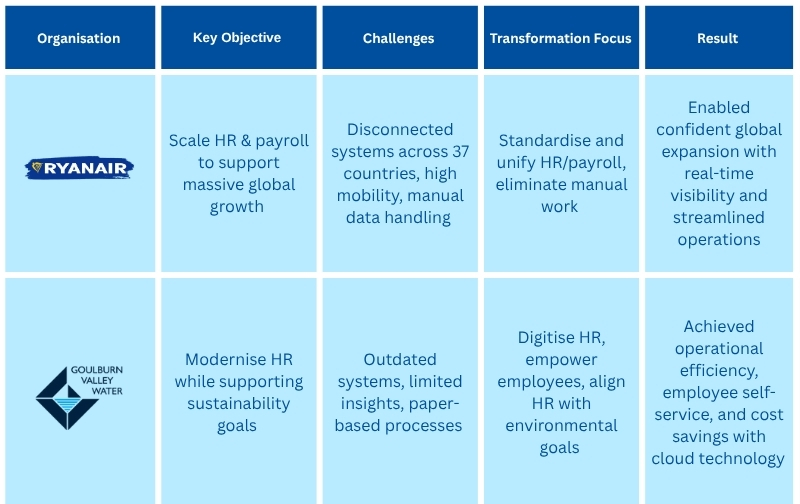When “Good enough” starts holding you back
In mid-sized organisations, HR and Payroll systems often live in a grey zone, not failing, but not enabling either. Initially fit-for-purpose, they become bottlenecks as business complexity increases.
We see this consistently in health checks and transformation programmes. Legacy systems create fragmentation. Onboarding delays, disconnected data, manual payroll across disparate tools, these issues slowly erode HR’s strategic role, forcing teams into operational firefighting.
The result? HR becomes reactive, not proactive.
Approximately 80% of SAP customers are small and midsize businesses. While this segment is growing rapidly, many of these organisations lack the internal IT capacity or governance structure typical of larger enterprises.
As compliance requirements, talent expectations, and operational complexity increase, mid-sized companies often face transformation with limited resources and rising urgency. Choosing the right implementation approach, one that balances speed, scalability, and support, is critical to ensuring long-term success.
A recent Deloitte report confirms that mid-market organisations face unique transformation barriers:
- 63% say their HR tech does not support business growth
- 54% cite poor system integration as a top obstacle
- 72% rely on spreadsheets for key HR workflows
The tipping point: what leaders tell us before the switch
In mid-sized companies, we frequently hear phrases like:
These aren’t outliers, they’re typical precursors to change
The turning point usually comes when the cumulative impact of workarounds becomes unsustainable:
- HR teams can’t scale processes across regions
- Data isn’t trustworthy
- Compliance risks increase
- Talent visibility disappears
Crucially, mid-sized businesses aren’t failing, they’re outgrowing the systems they once depended on. But without a structured path forward, internal teams become overwhelmed, making change feel riskier than staying put.
Scaling without losing control: structured transformation that still feels personal
Growth brings complexity, but that doesn’t mean your systems have to. The key is finding a way to scale that supports your people, not sidelines them. For organisations like Ryanair and Goulburn Valley Water, transformation wasn’t just about new tools, it was about building a foundation that could evolve with their business while staying true to who they are.
These two stories show that transformation isn’t one-size-fits-all, but the right structure makes all the difference. Whether you’re scaling rapidly across borders like Ryanair or modernising with a strong local mission like GVW, success comes from aligning technology with your specific context, people, and goals. With the right partner, transformation can be both disciplined and human, enabling progress without losing what matters most.
Beyond efficiency: Skills-based HR in action
Once operational control is restored, the next shift begins, from transactional HR to capability-led growth. That’s where skills-based talent strategies come into focus.
With SAP SuccessFactors technology and Zalaris frameworks and methodologies, mid-sized businesses are creating skills ecosystems that evolve with the workforce.
Core capabilities enabled:
1. Skills intelligence framework
- Skills are automatically inferred from job profiles, learning completions, performance forms, and project history.
- Skills are validated by employees and managers, ensuring data integrity.
- Team-level heatmaps show current capability and highlight gaps.
2. Smarter talent acquisition
- Job descriptions enriched with AI-generated skill clusters.
- Candidate profiles scored based on skill compatibility.
- Interview guides tailored to required competencies, improving hiring objectivity.
3. Performance-driven growth paths
- 360-degree reviews and goals data feed into the growth portfolio.
- Employees can explore AI-suggested career paths based on their skills and interests.
- Integrated development journeys link learning, mentoring, and assignments.
4. Strategic workforce planning
- Combine internal and contingent worker data via SAP Fieldglass.
- Use Workforce Analytics to model skill demand, supply, and risk areas.
- Enable leadership to see where capability is growing and where it needs to.
The result is an HR operating model that adapts to business change, not one that resists it.
A shared journey and a smarter way forward
Mid-sized organisations don’t always have the luxury of time, budget, or large internal teams. But they have something else: adaptability. Every organisation we’ve supported had already built incredible resilience they just needed the right tools and structure to move from coping to scaling.
Transformation doesn’t need to be massive to be meaningful. And it’s not about following someone else’s blueprint, it’s about building your own, with confidence.
Ready to learn from those already moving?
You don’t have to make this journey alone or guess where to begin. Mid-sized companies are already modernising HR and payroll in practical, measurable ways. And you can too. Contact us to get started.


